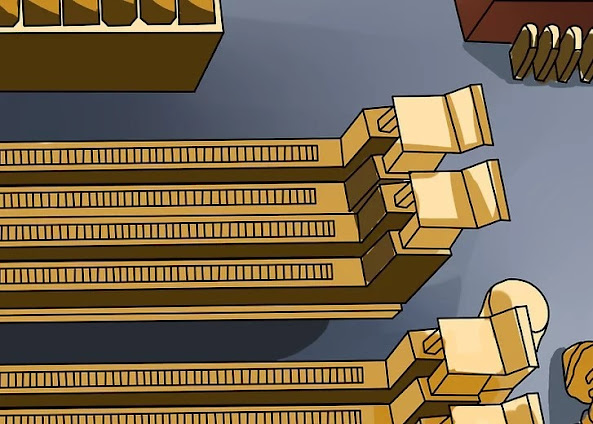Has your computer slowed down a little? It may not work the way it used to or it may not keep up with the latest software. Random Access Memory (RAM) upgrades are one of the easiest and cheapest ways to quickly improve your computer's performance.
1.
Buy RAM that is compatible with your computer. RAM comes in a variety of models, sizes, and speeds. The type to buy depends on your motherboard. See the documentation that came with your motherboard or computer, or check the manufacturer's website for the RAM specifications that the hardware supports.
There is a limit to the number of RAM modules you can install on your motherboard. Some motherboards only support two, while others support four, six, or more. Most motherboards have a limit on the amount of memory they can support, regardless of the number of slots.
It's also important to note that not all PCs are upgradeable. If in doubt, contact your PC manufacturer.
There is no guarantee that mismatched RAM will work together. So if you want to buy multiple units of RAM, buy two or more sets of them.
2.
Turn off your computer. As soon as you have the RAM, unplug the power cord from the PC and any peripheral devices connected to your computer, such as monitors, keyboards, and mice.
3.
Open the computer case. Lay the computer tower on its side so that you can access the motherboard when you remove the side panels. You may need a Phillips screwdriver to remove the bezel. Alternatively, you can loosen the screws by hand.
4.
Dissipates static electricity. Make sure your body is free from static electricity. Static electricity can damage computer parts and go unnoticed by people. Ground yourself or wear an anti-static wrist strap before you begin.
When the plug is unplugged, you can ground it by touching the metal part of the computer case. Make sure it is not plugged in, as simply turning it off will not remove the standby voltage.
Do not stand on the mat while you are working on your computer.
5.

Find the RAM slot. Most motherboards have 2 or 4 RAM slots. The RAM slot is usually located near the CPU, but its location may vary depending on the make and model. Look for a narrow slit about 4.5 inches long with tabs on either end. At least one of the slots already has a RAM bar.
6.
Remove the old RAM (if you are upgrading). To replace the old RAM, press the clips on either side of the slot to remove it. You can lift the RAM directly off the motherboard with little to no force.
If you have to pull hard, the clamp may not be fully lowered. You may need to press down on the clip with one hand and remove the RAM with the other.
7.
Take the new RAM out of the protective bag. Carefully remove the RAM from the shielded package. Hold from the side so as not to touch the contacts on the bottom or the circuitry on the board.
8.
Plug the RAM into the RAM slot. Align the notch in the RAM with the notch in the slot. Insert the stick into the slot and apply even pressure to the stick until the side clips click to lock the RAM in place. It only fits one way. So if it's not properly aligned, flip it over. You may need to put a lot of pressure on it, but don't force it.
Make sure the appropriate pair is plugged into the appropriate socket. You may need to refer to the motherboard layout diagram, but some are on the motherboard or labeled in color.
Repeat this process for each installed RAM stick.
With the PC open, use a cylinder of compressed air to remove the dust. This can be a quick fix to common overheating and performance issues. Air cans can be bought at any office supply store.
9.
Put the case back on your PC. After inserting the main memory, you can put the panel back on and fasten it with screws. Do not run your computer with the panel turned off. In fact, the cooling capacity of the fan is reduced. Connect peripherals and replace the monitor.
10.
Turn on your computer. Your computer should boot normally. If a self-test appears on your computer when it boots, you can verify that the RAM is installed correctly. If not, you can check to see if the RAM was installed after Windows booted.
If your PC does not boot, the RAM may not be installed properly. Turn off your PC and open it again. Then remove and reinstall the RAM. Make sure you hear a click and try again.
11.
Check the RAM in Windows. Press Windows Key + Pause / Pause to open System Properties. RAM is displayed in the System section or at the bottom of the window.
Operating systems calculate memory differently, and some computers allocate a certain amount of RAM to certain functions, such as video, to reduce the amount available. For example, if you bought 8GB of RAM, you might only see about 7.78GB of available storage.
12.
If you have any problems, run a RAM test. If you are not sure if the memory is installed correctly or if your computer is not working properly after installing it, you can test your memory using the Windows Memory Diagnostic Tool. It may take a while to run, but an error is detected and the amount installed is displayed.
To run the tool, press the Windows key on your keyboard and type storage in the search bar. Click Windows Memory Diagnostics to start the tool, and then click Restart Now to view the problem and run the diagnostics.











No Comment to " How to Install RAM "